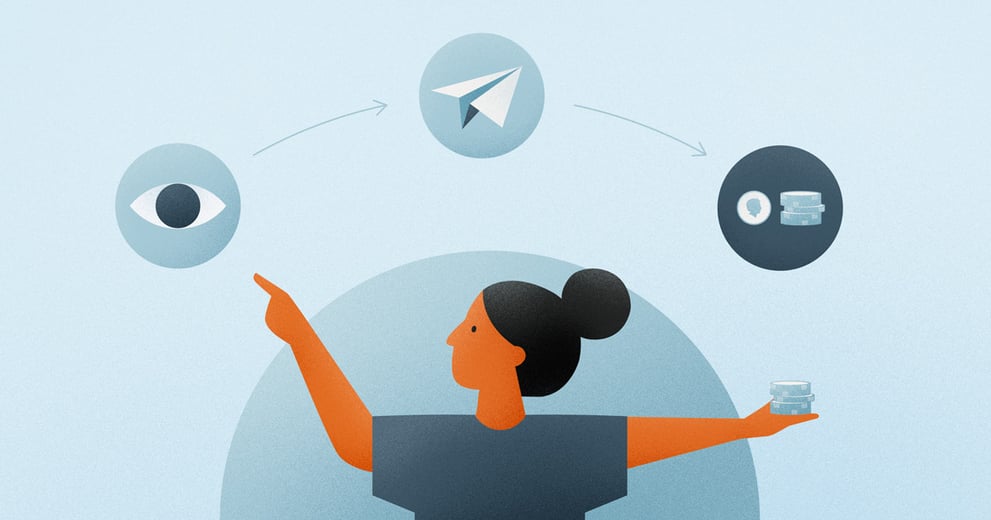Introducing Zeller for Startups.
Don’t waste time assembling disparate tools or waiting in line at a bank. Zeller for Startups is an all-in-one financial solution for founders, by founders.
6.05.2022

Think of the marketing funnel as a visual framework through which a person becomes a paying customer. They begin at the top of the funnel (at its widest point) when they first become aware of your business, and finish at the bottom as a paying customer. Typically, not everyone who is aware of your business will convert, which is why the funnel grows tighter the further it progresses through the funnel stages.
You’ve no doubt seen a marketing funnel before. Yet there is no one universally recognised marketing funnel. The name itself even has a few different variations, including customer funnel, purchase funnel, sales funnel, conversion funnel.
Regardless of the particular funnel you are using, the chronological process of converting customers involves:
A marketing funnel essentially breaks down the stages a customer goes through when making a purchase decision. That’s why the marketing funnel is considered a blueprint to conversion. It helps you understand what motivates your customers to purchase, when to engage with them, and what’s not working with your current approach.
It can help you plan your marketing efforts strategically, enabling you to guide prospects through the funnel with less drop-off — meaning more paying customers. Another core benefit of understanding your marketing funnel in place is measurability. You can quickly identify where exactly in the funnel you’re losing customers, allowing you to adapt and adjust your strategy as you go.
This insight can also help predict future sales volumes. If your usual conversion rate is 5% and you’ve just successfully acquired 1,000 new email subscribers off the back of a marketing campaign announcing the release of a new yearly journal in the last 7 days, you can anticipate 50 additional sales.
The marketing funnel works as a whole; potential customers go from stage to stage, all the while getting closer to making a purchase. That’s why your business needs to be marketing to customers at every stage of the funnel.
Known amongst marketers as TOFU (meaning top of the funnel), the awareness stage is where prospective customers discover your business for the first time. They might have engaged with an Instagram ad, or found your website on Google. Your customers could be anywhere — that’s why a strong brand presence across multiple channels is key to growing awareness.
At this point, the prospective customer doesn’t know a lot about your brand — which is why your marketing at this stage should focus on introducing the brand and its offering to people who have a want, or a need, for it.
Some examples of marketing strategies for the awareness stage include:
The middle of the funnel, also called MOFU, is where people who have meaningfully engaged with your brand sit. These people might have followed your business on Instagram or subscribed to your mailing list, for example.
These potential customers will likely be weighing up their options, which means earning their trust is key to beating the competition. This is where you set your brand apart as the superior option. You do this by focusing on your unique selling points.
Marketing strategies to help build momentum in the consideration stage of the funnel include:
The bottom of the funnel (BOFU) is where you give prospective customers the final nudge towards purchase. At this point, you’ve caught their attention, established trust, and forged a brand relationship. Now it’s simply a matter of conversion.
This stage is the most crucial, since it is the one that brings in revenue. It’s ok to be more direct; these people are already aware of your brand, and your offering. Some examples of marketing that can help to finalise the sale include:
In-store, the quickest way to convert a potential customer who may be on the fence about making the purchase that day is to remove any unnecessary hurdles to purchase. An agile and intelligent EFTPOS system like Zeller Terminal will enable your customers to pay however is most convenient for them, and help to minimise long lines.
Once you understand your marketing funnel, you can identify opportunities to make changes to improve your return on investment and grow your business.
Here are some simple ways to supercharge your marketing funnel:
The marketing funnel is a strong foundation upon which to build your marketing strategy. Paying attention to your marketing funnel will help align marketing activity to purchasing motivations, ensuring you’re getting a return on the time and money you’ve spent converting customers.
Now that you know the power of the marketing funnel, sign up to the Business Blog to cash in on valuable insights sent straight to your inbox.